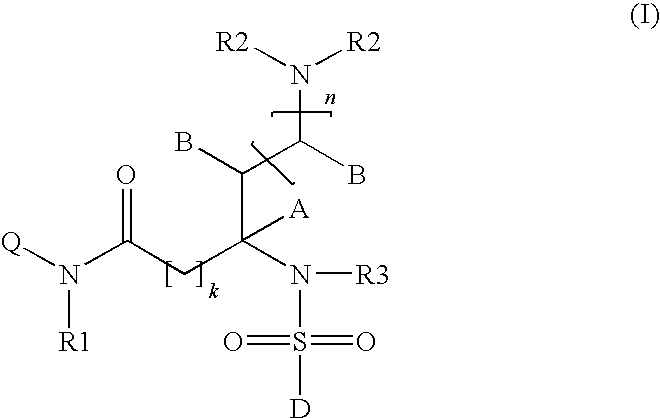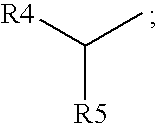Somatostatin receptor 1 and/or 4 selective agonists and antagonists
a technology of somatostatin receptor and selective agonist, applied in the field of hetero-arylsulfonylamino based peptidomimetics, can solve the problems of short biological half-life of somatostatin, unsatisfactory as medicines, and peptides with a very limited ability to penetrate membranes
- Summary
- Abstract
- Description
- Claims
- Application Information
AI Technical Summary
Benefits of technology
Problems solved by technology
Method used
Image
Examples
example 1
Synthesis of 5-amino-N-(3-chlorobenzyl)-(S)-2-(N′-(1-naphthalenesulfonyl)amino)pentanamide
Step I
[0238]Fmoc-Orn(Boc)-OH (70.0 mg, 454.52 g / mol, 0.15 mmol, 1 eq), DIC (24.1 μl, 126.20 g / mol, 0.806 g / cm3, 0.15 mmol, 1 eq) and HOBt (20.8 mg, 135.12 g / mol, 0.15 mmol, 1 eq) were dissolved in dry DMF / DCM (1 / 1, 5 ml). After 5 minutes 3-chlorobenzylamine (18.8 μl, 141.60 g / mol, 1.159 g / cm3, 0.15 mmol, 1 eq, Acros) was added to the reaction mixture. According to TLC analysis, reaction was complete after overnight stirring. Solvent was then evaporated and the yellow residue was purified with flash chromatography. 5-(N-Boc-amino)-N′-(3-chlorobenzyl)-(S)-2-(N″-Fmoc-amino)pentanamide as white foam was obtained with quantitative yield.
Step II
[0239]Fmoc protection was removed by dissolving the 5-(N-Boc-amino)-N′-(3-chlorobenzyl)-(S)-2-(N″-Fmoc-amino)pentanamide in 5 ml of 20 vol-% piperidine in DMF. After 30 minutes stirring, solvent and excess of piperidine were evaporated. Product was used withou...
example 2
Synthesis of 5-amino-(S)-2-(N-(4-methyl-1-naphthalenesulfonyl)amino)-N′-(phenyl)pentanamide
Step I
[0244]Fmoc-Orn(Boc)-OH (50.0 mg, 454.52 g / mol, 0.11 mmol, 1 eq), DIC (17.2 μl, 126.20 g / mol, 0.806 g / cm3, 0.11 mmol, 1 eq) and HOBt (15.0 mg, 135.12 g / mol, 0.12 mmol, 1 eq) were dissolved in dry DMF / DCM (1 / 1, 4 ml). After 10 minutes aniline (10.0 μl, 93.13 g / mol, 1.022 g / cm3, 0.11 mmol, 1 eq, Acros) was added to the reaction mixture. After overnight stirring, temperature was raised to 40° C. and kept there for 2 hours. Solvent was then evaporated and residue purified with flash chromatography. 5-(N-Boc-amino)-(S)-2-(N′-Fmoc-amino)-N″-(phenyl)pentanamide as white powder was obtained with quantitative yield.
Step II
[0245]Fmoc protection was removed by dissolving the 5-(N-Boc-amino)(S)-2-(N′-Fmoc-amino)-N″-(phenyl)pentanamide in 5 ml of 20 vol-% piperidine in DMF. After 45 minutes stirring, solvent and excess of piperidine were evaporated. Product was used without purification for step III.
S...
example 3
Synthesis of 5-amino(S)-2-(N-(4-methyl-1-naphthalenesulfonyl)amino)-N′-((R)-1-(2-naphthyl)ethyl)pentanamide
Step I
[0250]Fmoc-Orn(Boc)-OH (100.2 mg, 454.52 g / mol, 0.22 mmol, 1 eq), DIC (34.4 μl, 126.20 g / mol, 0.806 g / cm3, 0.22 mmol, 1 eq) and HOBt (29.7 mg, 135.12 g / mol, 0.22 mmol, 1 eq) were dissolved in dry DMF / DCM (1 / 1, 4 ml). After 10 minutes (R)-1-(2-naphthyl)ethylamine (37.7 mg, 171.24 g / mol, 0.22 mmol, 1 eq, Acros) was added to the reaction mixture. After overnight stirring, temperature was raised to 40° C. and kept there for 2 hours. Solvent was then evaporated and residue purified with flash chromatography. 5-(N-Boc-amino)(S)-2-(N′-Fmoc-amino)-N″-((R)-1-(2-naphthyl)ethyl)pentanamide was obtained with quantitative yield.
Step II
[0251]Fmoc protection was removed by dissolving the 5-(N-Boc-amino)(S)-2-(N′-Fmoc-amino)-N″-((R)-1-(2-naphthyl)ethyl)pentanamide in 5 ml of 20 vol-% piperidine in DMF. After 45 minutes stirring, solvent and excess of piperidine were evaporated. Product w...
PUM
 Login to View More
Login to View More Abstract
Description
Claims
Application Information
 Login to View More
Login to View More - R&D
- Intellectual Property
- Life Sciences
- Materials
- Tech Scout
- Unparalleled Data Quality
- Higher Quality Content
- 60% Fewer Hallucinations
Browse by: Latest US Patents, China's latest patents, Technical Efficacy Thesaurus, Application Domain, Technology Topic, Popular Technical Reports.
© 2025 PatSnap. All rights reserved.Legal|Privacy policy|Modern Slavery Act Transparency Statement|Sitemap|About US| Contact US: help@patsnap.com



